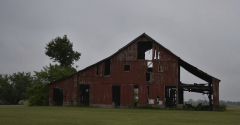Sam Nicholls is an MA student in the Department of History

‘Old red dilapidated see thru barn’ by Roger Starnes Sr, via Unsplash.com
I’ve spent a lot of time in heritage institutions – as both visitor and employee. I’m sure if you’re reading this post, that you also have likely spent some time within these organizations, at either the local or national level. My experience in local cultural heritage organizations has always been great, yet each interaction has presented the various challenges presented to heritage organizations, specifically at the smaller, local level. Several of these challenges are rooted in a lack of access to digital resources.
Currently, I am working on a project for the X-Lab that addresses these digital challenges head on. I designed a series of survey questions that we’ve circulated among various cultural heritage institutions in the Ottawa region, from Hawkesbury to Smiths Falls to Petawawa. We want to discover the various needs of these regional and local cultural heritage institutions and identify the digital gaps that have emerged for various organizations. Although the project is still at its beginning stages, its already interesting to see the divergences and trends that have presented themselves. While some organizations clearly require an upgraded website (which is a project that can be difficult in areas where internet access might be limited; also, content management software can be difficult to navigate when bandwidth is an issue), other organizations are well past this stage, unsure how to move forward and potentially overwhelmed by the numerous software and digital strategies that are available to them.
I was passionate about this project from the very beginning. It not only meant that I could engage with organizations and learn histories that were new to me (woohoo!), but it has also given me the opportunity to really dive deep into some of the challenges that face smaller organizations in what is arguably now one of the most foundational parts of museum work – digital presence. In an increasingly digital world, historical researchers, enthusiasts, tourists, and locals are turning to digital resources for their information and source material. Unfortunately for smaller organizations with less access to funding and even training, important local histories are becoming more and more inaccessible. What happens when a platform begins to crumble (Twitter), a company sheds employees (Facebook), or a company loses interest in supporting a product (Google)? In this process, histories become lost among the digitized versions accessible through large-scale data bases provided by bigger, national, or provincial museums. Smaller organizations’ lack of a digital presence also inhibits the work of researchers who are seeking out local histories but rely on digital platforms to find them. These challenges were presented especially during the COVID-19 pandemic, where historical research was limited, even paused, until archives, museums and historic sites reopened their doors. (Read more here: https://activehistory.ca/2020/03/a-time-for-research-distancing/)
This project’s focus on the ‘local’ or smaller museums is integral to the type of support that the study hopes to provide. The project’s reliance on privileging of community voices (the museum community, that is) will also provide insight into which resources that researchers, academics, funding agents and institutions can provide to support places that do the same work, but on a smaller scale. Although a project like this may have predictable outcomes, its importance lies with its interconnectivity and privileging of community voices. Unless cultural heritage organizations are addressed directly, digital funding and research initiatives may be seen as inauthentic, and not a true reflection of institutional needs.